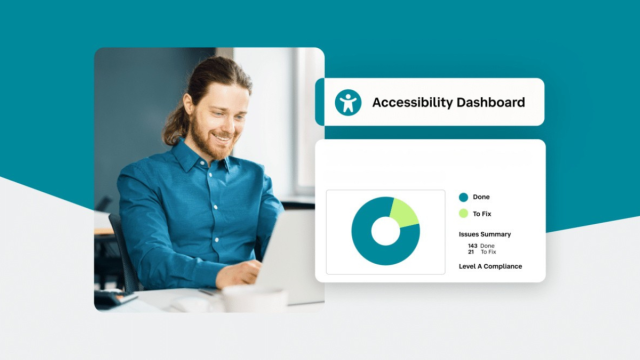A big part of ensuring that your website is up to date is to make sure that it is accessible to as many users as possible. With over a billion people disabled around the globe, companies that do not take web accessibility seriously tend to lose out on the number of people they can interact with. Proper inclusivity also enhances the overall user experience, increases SEO efforts, and minimizes the chances of getting sued.
But how do companies achieve satisfactory website accessibility while complying with the law? Here are some reasons why web accessibility matters, the most appearing issues, and how EqualWeb AI-powered website accessibility checker solves them.
Accessibility Defined
Contents [show]
Website accessibility means providing disabled users with fruitful services in sight, hearing, motor skills, and cognition. By being accessible, companies will try to create an experience for all users irrespective of their abilities.
Some common accessibility barriers can be:
• Text that is hard to read as a result of poor color combination can create significant issues for visually impaired users.
• Users who rely on a screen reader cannot grasp the visuals presented in images because of the absence of alt texts.
• Using a mouse for navigation can become problematic because not everyone can use one. Those who cannot use the mouse are often neglected, as navigation via keyboard is not considered.
These are inaccessible forms, which affect users with disabilities by preventing them from providing necessary information.
Overviews Website Accessibility Necessities
1. Mitigating Risks plus Legal Compliance
Not complying with website accessibility standards can get you into legal trouble. Using the American Disabilities Act, all businesses must provide equal service access through digital means. Recently, lawsuits against companies with non-compliant websites have increased dramatically, making compliance possible.
2. Increased Website Ranking and SEO
Adherence to the website’s accessibility also helps to improve SEO optimization. An accessible website is Google and other search engine friendly. User-friendly websites with easy navigation, proper placement of headings, and adequate descriptions of images are prioritized by Google, which are the basics of providing accessibility.
3. Improved Overall Experience for Users
Accessible websites are advantageous not only to users with disabilities but to all. Keyboard input captioning, appropriate arrangement of text, and multimedia materials with captions help users with disabilities plus everyone else for more significant interaction and fewer visitors leaving the page without looking at the content.
4. Increased Sales and Audience Reach
By providing accessibility for your website, you widen the audience base to include those dependent on assistive devices. More customers mean more businesses are catered to, resulting in greater brand loyalty and sales.
Barriers to Reaching Web Accessibility
There are many accessibility benefits, yet most businesses struggle with it because of the following reasons:
• Not enough knowledge of standards such as WCAG.
• Website designs that is overly complicated and hard to restructure to fit accessibility standards.
• For smaller businesses, the resources to comply with these standards are limited and difficult to use.
Challenges EqualWeb’s AI-Powered Insight Can Work On
If your business wants an easier way to comply with these, EqualWeb’s ADA and WCAG-compliant website accessibility checker is the answer. This tool helps companies locate and fix compliance accessibility nonconformance issues while ensuring compliance with these laws.
Benefits of EqualWeb ADA and WCAG Compliant Website Accessibility Checker
• Automated Website Audits: The tool scans for accessibility issues and identifies them with a comprehensive report summary.
• Real-Time Fixes: The AI solves real-time advanced problems requiring high cognitive energy, significantly reducing manual labor.
• Customizable Accessibility Widget: Users can modify the browsing experience to their liking and increase engagement.
• Ongoing Monitoring & Compliance Certification: It’s sure that any accessibility changes made last over time, and a certificate can be provided to show compliance.
Effective Measures to Enhance Website Accessibility
Apart from utilizing EqualWeb, companies may consider the following measures to ensure that the site is accessible to everyone:
• Visually impaired users should be provided alt text descriptions for images that address the visual content.
• Structure content using proper headings (H1, H2, H3, etc.) to enhance navigation.
• Provide video and audio content transcripts and captions.
• Facilitate keyboard navigation to ensure users can navigate without a mouse.
• Utilize assistive technologies to evaluate your website, determine what barriers exist, and how to fix them.
To learn more about how to best work on your digital strategies, view this article on website optimization.
Your Takeaway: Don’t Ignore Accessibility
Regarding web accessibility, default compliance no longer cuts it – it’s now an excellent opportunity for enhancing user experience, boosting your SEO, and ultimately growing your business. With artificial intelligence digital tools like EqualWeb’s website accessibility checker, companies can quickly meet requirements and foster a compliant digital space.
Take the first step now. Please do not sit on accessibility problems until they become issues. You can start by improving your website today. Read TechWalls for the latest insights and expert recommendations on digital marketing strategies and website optimization.


